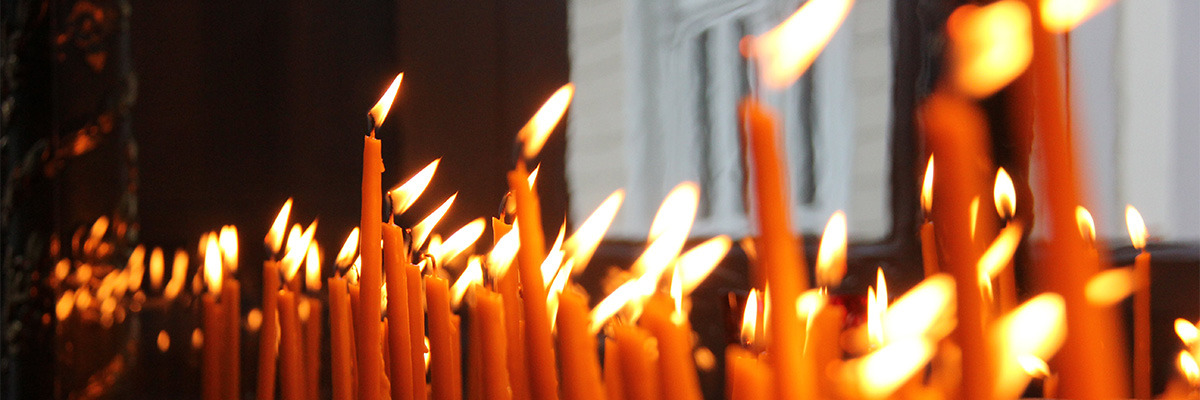
All Saints, All Souls, and the Faithful Departed
By William Dohar
Broadly speaking, you might call the three consecutive days of Oct. 31, Nov. 1, and Nov. 2 a kind of Venn diagram of the dead.
The origins of each—Halloween, All Saints’ Day and All Souls' Day—are connected to those who have died, and have roots in Catholic traditions, says William Dohar, a senior lecturer in religious studies who teaches the popular course “Witches, Saints, and Heretics.”
While Oct. 31 conjures our traditions of costumes, candy and jack-o-lanterns, it’s mostly Catholics who were taught that Nov. 1 marks a Holy Day of Obligation honoring the saints of the church, while Nov. 2 commemorates the faithful departed in purgatory who have been saved, but need our prayers to enter heaven.
But how did they happen to line up over 72 hours?
“It is a bit of an autumn brew,” says Dohar, “with lots of layers and coincidences.” Below, he breaks it down into meaningful pieces.
When and where does the story begin?
This particular tradition starts before Christianity, during the autumn celebration at the end of the harvest called Samhain, mainly in Northern Europe with the Celts (the early Irish) who will have an influence on what happens on the continent.
They celebrated this sort of final day of their year in terms of the harvest, at the end of the 10th month, with various kinds of festivities that had to do with souls and spirits. The belief was to look back over the arc of the last year, and acknowledge not only the harvest and bounty, but also those who had passed on.
This is the time when the spirits return to their families, to their homesteads, and people wore costumes and masks to ward off ghosts, and carved menacing faces into gourds and pumpkins and placed them in windows. It also inspired their tradition of making special “soul cakes” to put on the steps of their homes so the spirits might not bother those inside the house; it was a kind of precursor to the candy offered to trick-or-treaters today.
So the beginnings of something become very important for these ancient cultures, and when Christianity arrives in the early Middle Ages, there was a conscious effort not to try to destroy these pagan holidays, but rather to baptize them.
How does All Saints’ Day start?
All Saints’ was established in the seventh century in Rome in a church that was formerly the Pantheon, a pagan temple that had been given to the Pope by the Emperor. Because of the Pantheon’s association with the Roman Empire, the Pope honored it as a way of remembering all those Christian martyrs of Rome, many of whose names are unknown. So that becomes the Church of All Saints, and the Pope consecrates May 13 as All Saints’ Day to honor the people who have attained Heaven.
Just around that time, Irish monks who knew the old pre-Christian autumn festival—which they had sought to reform—were exerting new influences on the continent. They established monasteries in places like France and Germany and Italy, and local churches were influenced by the Irish, who had been celebrating the end of October to honor the dead, which came to be known as All Hallow’s Eve. So it becomes kind of reasonable to universalize the celebration of the saints, and by the eighth century, the Pope declares All Saints’ Day will be Nov. 1. The May date was valued by the church and the city of Rome, but not to many people beyond that.
This is a continuation of the sacralizing process I mentioned before, where the medieval missionaries didn’t own the pre-Christian tradition that honored the dead in late October, but rather built on it, baptized it, transformed it.
Who are the saints in heaven?
They are saints in the Church who are known—apostles, saints of the Middle Ages, or modern period—and unknown, like the Christian martyrs. Or, for instance, they might be drawn from the collective memory of a village or community about a great person who may not be known anywhere else but to the people in that community, and there is a common description that this person is surely with God.
All Souls' Day follows on Nov. 2. What are the chances, er, circumstances, that it landed right after All Saints'?
All Souls' Day was established on Nov. 2 by Odilo, a famous and long-lived abbot of Cluny in the 10th century, to follow All Saints’ Day and commemorate the souls in purgatory. It was adopted by the Church in the 18th century. These are all the other souls who are not yet with God, so we celebrate their memory and honor their lives, and in a Christian context we pray for their continued transformation.
In Dante’s “Divine Comedy,” he devotes a volume to each part of a soul’s journey to God: hell, purgatory, and heaven—all in this movement upward. Purgatory is a kind of discrete place where people who made some mistakes in life exist, and aren’t quite ready to join the communion of saints in heaven. We are taught to believe that through our actions such as prayers, visiting the graves of our loved ones, lighting candles or having Masses said in their memory, that we can help release them from purgatory.
What lesson can we learn from this history?
It shows how these things have evolved over time. It wouldn’t be a very effective missionary who said to the people, “That date, or that time, or that celebration no longer exists. We're going to do something else at another time.” It wouldn't have made sense to the people, but from the Church’s point of view, if you take something like Samhain, or the celebration of the dead in the combination of All Saints’ and All Souls,’ you have the language changes, but the reality kind of remains what it’s been for a long time. That’s why we have Halloween to this day. It’s clearly a pre-Christian thing that has held on because it wasn’t eradicated.
Photo courtesy of Pexels.

